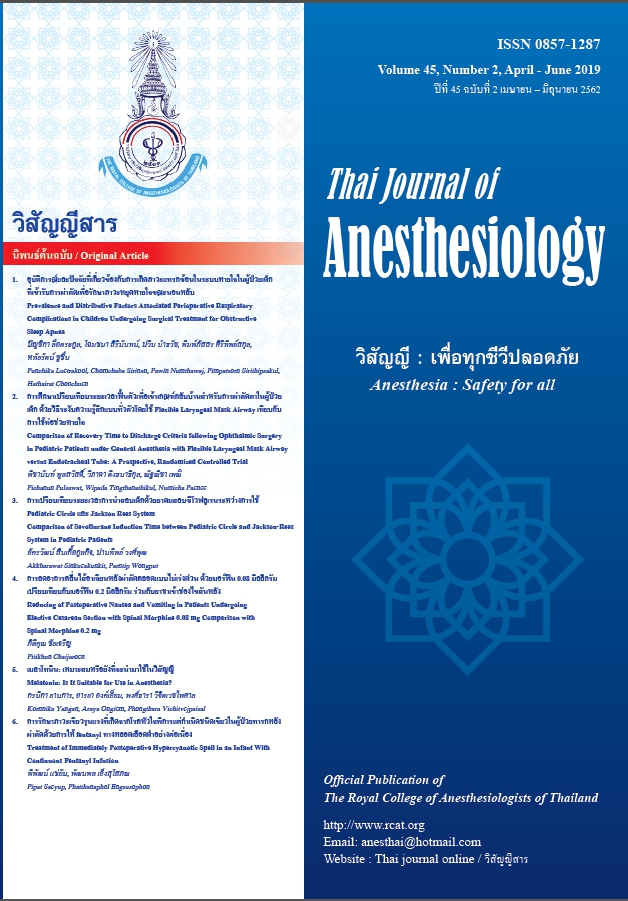การรักษาภาวะเขียวรุนแรงที่เกิดจากโรคหัวใจพิการแต่กำเนิดชนิดเขียวในผู้ป่วย ทารกหลังผ่าตัด ด้วยการให้ fentanyl ทางหลอดเลือดดำอย่างต่อเนื่อง
Main Article Content
บทคัดย่อ
ภาวะเขียวรุนแรงที่เกิดจากโรคหัวใจพิการแต่กำเนิด
ชนิดเขียว (TET spell หรือ hypercyanotic spell) เป็นภาวะ
ที่อันตรายถึงชีวิต การให้ยากล่อมประสาทเป็นการรักษา
ที่สำคัญ มีจุดประสงค์เพื่อให้ผู้ป่วยสงบ ลดการกระตุ้นระบบ
ประสาทส่วนซิมพาเทติก และยับยั้งกลไกพยาธิสภาพของ
การเกิดภาวะเขียวรุนแรง รายงานผู้ป่วยนี้ต้องการชี้ให้เห็นถึง
ความสำคัญของการให้ยากล่อมประสาท คือการให้ fentanyl
ทางหลอดเลือดดำอย่างต่อเนื่อง เพื่อรักษาอาการเขียวรุนแรง
เฉียบพลับหลังจากการผ่าตัด
ผู้ป่วยทารกเพศชายอายุแปดเดือน มีโรคหัวใจพิการ
แต่กำเนิดชนิดเขียวที่ยังไม่ได้รับการรักษา และมีอาการเขียว
เฉียบพลันทันทีหลังการผ่าตัดเสร็จสิ้น ออกซิเจนในเลือดต่ำ
จนถึงร้อยละ 65 ผู้ป่วยไม่ตอบสนองต่อการรักษาด้วยการจัด
ท่ายกเข่าชิดอก การให้ยาเพิ่มการหดตัวของหลอดเลือด
และการให้สารน้ำเพิ่ม แต่อาการกลับดีขึ้นภายในเวลาอันสั้น
หลังจากให้ยาที่มีฤทธิ์กล่อมประสาท และแก้ปวดคือ การให้
fentanyl ทางหลอดเลือดและให้อย่างต่อเนื่อง สุดท้ายผู้ป่วย
ได้รับการผ่าตัดหลอดเลือดทรวงอกเพื่อเพิ่มเลือดไปที่ปอด
วันที่ 20 หลังจากวันผ่าตัดแรก สรุป: การให้ fentanyl
ทางหลอดเลือดดำอย่างต่อเนื่อง เป็นอีกการรักษาทางเลือก
หนึ่งที่ช่วยรักษาภาวะเขียวรุนแรงที่เกิดจากโรคหัวใจพิการ
แต่กำเนิดชนิดเขียว อีกทั้งช่วยกล่อมประสาทและบรรเทาหลัง
จากการผ่าตัด
Article Details
เอกสารอ้างอิง
Tetralogy of Fallot with isolated cyanosis. Case reports in
pediatrics 2018; Article ID 7412869:1-4.
2. Michelle CW, James MP. Anesthetic management of children
with congenital heart disease for non-cardiac surgery.
Continuing education in anesthesia, Critical care & pain
2012;12:17-22.
3. Amruta VH, Sanjat SY. A case of uncorrected adult Tetralogy
of Fallot for emergency decompressive craniotomy: An
anesthetic challenge. Medical journal of Dr. D.Y. Patil
Vidyapeeth 2016;9:768-70.
4. Hideaki S, Hirotaka I, Yoichi I, et al. Sedation of
hypercyanotic spells in a neonate with Tetralogy of Fallot
using dexmedetomidine. J Pediatr (Rio J) 2008; 84: 377-80.
5. Daniel ST, Yaffa MV, Joel B, Thomas JS, Peter SD. Treatment
of Tetralogy of Fallot hypoxic spell with intranasal fentanyl.
Pediatrics 2014;134:266-69.
6. Sanford TJ Jr, Smith NT, Dec silver H, Harrison WK.
A comparison of morphine, fentanyl, and sufentanil
anesthesia for cardiac surgery: induction, emergence and
extubation. Anesth Analg 1986;65:259-66.
7. Benthuysen JL, Folt BD, Smith NT, Sanford TJ Jr, Dec-Silver
H, Westover CJ. Prebypass hemodynamic stability of
sufentanil-02, fentanyl-02 and morphine-02 anesthesia
during cardiac surgery: a comparison of cardiovascular
profiles. J cardiothorac Anesth1988;2:749-57.
8. Freedom RM, Benson LN. Tetralogy of Fallot. In: Freedom
RM, Benson LN, Smallhorn JF, editors. Neonatal heart
diease. Heidelberg: Springer-Verlag; 1992. p 213-24.
9. Green SM, Denmark TK, Cline J, Roghair C, Abd Allah S,
Rothrock SG. Ketamine sedation for pediatric critical care
procedures. Pediatr Emerg Care 2001;17:244-8.


